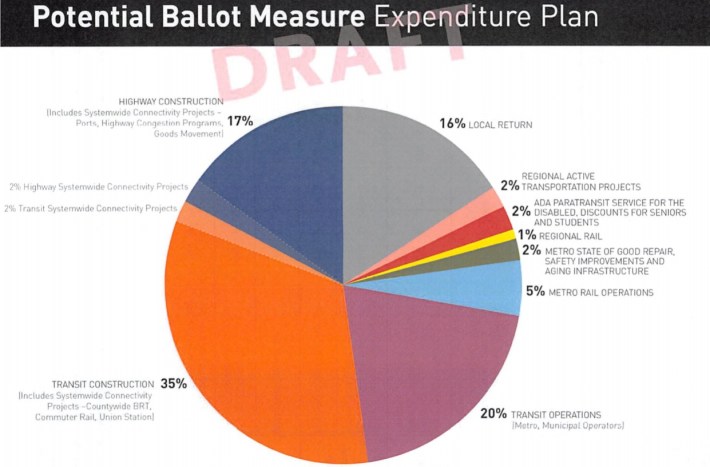L.A. City Already Looking At How To Carve Up $4B Local Return
1:00 PM PDT on May 26, 2016

Metro has not yet decided whether to have a Measure R2 sales tax on the November ballot; that will come next month. The voting public has not yet passed the measure by two-thirds; that would hopefully come in November. But the L.A. City Council is already trying to decide how to spend their chunk of the future funds.
At yesterday's council Transportation Committee, members considered a pair of motions that would carve up the city's anticipated $4 billion in "local return" funds:
- Councilmembers Bob Blumenfeld and Paul Koretz' motion 16-0187 would divide up local return "by region and Council District" in order to "ensure that the San Fernando Valley and all regions receive their fair share."
- Councilemembers Joe Buscaino, Mitch Englander, Herb Wesson and Mike Bonin's motion 16-0395 would set aside a "minimum allocation of two-thirds of the City’s share of potential Local Return funding for a capital improvement program for street reconstruction and rehabilitation." To a large extent this echoes Buscaino and Englander's 2012-2013 efforts toward a road bond.
As in the overall Metro expenditure plan, there is a delicate balance to be struck on these sorts of advance allocations. If the funding direction is too vague, or if it is too specific, voters may find reasons to not support Measure R2.
There are competing ways to divide the money, and as Transportation Committee Chair Bonin stated, "equality is not equity." Valley interests urged equality: ensuring all regions get an equal allocation. South L.A. speakers urged equity: ensuring that investment remedies historic deficiencies for underserved communities.
Livability advocates, including Investing in Place, were critical of the Buscaino-Englander motion as currently written. If the city spends the majority of its funding to merely repave streets and restore them as is, it would be a missed opportunity to implement Mobility Plan 2035, Vision Zero, and/or green infrastructure improvements. In addition, that motion currently ignores sidewalks, whether repairing or adding new sidewalks where they are missing.
This delicate balance was not resolved yesterday. Bonin instead proposed, and the committee affirmed, a series of requests that city departments report back to the Transportation Committee for further discussion.
Bonin's direction to staff follows after the jump.
For Motion 16-0187:
DIRECT the CAO and CLA, in coordination with the Department of Transportation and other affected departments, to report on the following:
1. Estimated amount of the City’s share of local return revenue that would be generated by Metro’s proposed 2016 half-cent sales tax measure.
2. The amount of the 3 percent local contribution that is required to fully fund the Metro rail construction projects located in the City of Los Angeles that are identified in the new ballot measure.
3. A recommended expenditure plan to use new local return funds for capital improvements, street reconstruction, and rehabilitation for streets that are in “D” and “F” condition, consistent with the Buscaino-Englander-Wesson-Bonin motion. This expenditure plan should include all of the staff and equipment resources necessary, including support for DOT field crews to keep pace with an expanded pavement improvement program.
4. Opportunities to leverage local return monies with state and federal grant dollars, as well as options for the City to bond against future revenues.
5. A priority list of operational and capital needs from the Department of Public Works and DOT.
6. As we consider policy decisions related to the expenditure of any new transportation funds, it is critical that we keep in mind the commitments that we have already made. To the degree that the policies or programs in the following initiatives require additional funding, they should be included in our consideration of how new local return funds should be expended. Therefore, the report should include consideration of:
a. Mobility 2035 Planb. Vision Zero Initiative and countermeasures for the High Injury Networkc. Safe Routes to School Strategic Pland. DOT’s Strategic Plane. Monthly Open Streets Eventsf. First/Last Mile Investmentsg. Transit Stop Capital Improvements, such as street lighting, benches, trash receptacles and repair of adjacent broken sidewalksh. Expansion of the bike and car share programsi. Expansion of the City’s DASH, Commuter Express, and Cityride servicesj. Completion of the traffic signal construction programk. Technology improvements that will enable communication between infrastructure and vehicles on the road.
7. The feasibility of allocating new transportation local return funds equally among all of the Council districts, and other options that would provide for a fair share distribution of new transportation funding resources.
For motion 16-0395:
INSTRUCT the CLA and CAO to include in their report a summary of available information relative to the City’s expenditure of transportation sales tax funds and the resources necessary to undertake more detailed analysis of the specific distribution of transportation projects and programs.
Stay in touch
Sign up for our free newsletter
More from Streetsblog Los Angeles
Metro Committee Approves 710 Freeway Plan with Reduced Widening and “No Known Displacements”
Metro's new 710 Freeway plan is definitely multimodal, definitely adds new freeway lanes, and probably won't demolish any homes or businesses
Automated Enforcement Coming Soon to a Bus Lane Near You
Metro is already installing on-bus cameras. Soon comes testing, outreach, then warning tickets. Wilshire/5th/6th and La Brea will be the first bus routes in the bus lane enforcement program.




